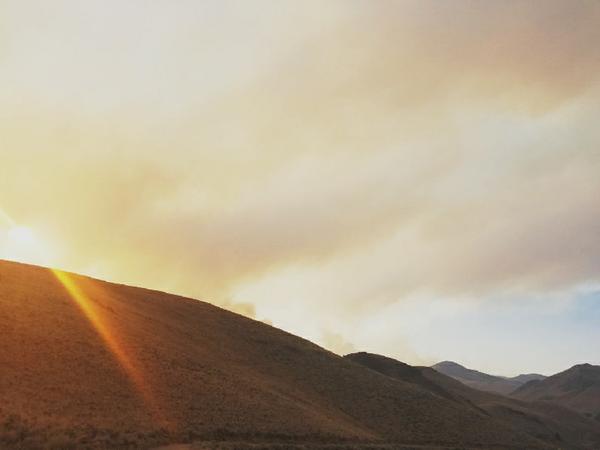
In my chest I could feel, rather than hear the pulse of the Helicopter’s rotors as they roared over, slicing through the hot, smoke hazed afternoon air. I was a sitting duck, a lone speck on a huge mountainside. I knew I would likely be spotted from the air. I wrestled the 300 pound motorcycle off of my mashed body, and clambered onto my feet.
I was up on my own recon mission of the Hat Creek ranges that were currently being burned by the Rabbit Foot Fire. The only difference was that I was bound to the ground on my own version of reconnaissance vehicle: my Suzuki DR350 dirt bike. It was the only way to cover the many miles I had to go to get a clear picture of what was happening. I had already traveled over 30 miles, 2 wheeling it over mountain roads, elk trails and two tracks, and now was on a 12-foot wide scrape down to bare mineral soil left by a Caterpillar D-6 Bulldozer.
It was a fireline, stretching over undulating peaks and canyon-like valleys for miles into the distant grayish blue haze, akin to the Great Wall of China. It was plowed across this virgin piece of wilderness mountainside in an attempt at flanking the monster blaze called Rabbit Foot. It was an ironic name, as the fire had nothing to do with good luck. The inferno was now over 30,000 acres in size, and was 0% contained. I knew by my map updates that the Incident Command team had been sending me by email on a daily basis that I was just barely outside of the complete closure area; fire command had judiciously placed a no personnel closure on the area immediately around the burn area to prevent human casualties.

If I just managed to wander 50 feet to the west, I could be slapped with a $5000 fine for closure breach, but thankfully, my life up there on the range over 13 years on horseback made my mind a better map than even the best GIS could produce. In my noggin was a map of this country that was clearer than the back of my hand.
My map bearing abilities were nothing special. Every one of my neighbors who had lived up in this country with their cattle had exactly the same thing going on. They knew their grazing country better than a NY cop knew his precinct. They remembered individual trees in the forest; glacial erratic boulders; where elk frequented; and were the best grass was. They recalled the tiny seep where they bumped into a she-wolf sipping a drink 6 years back, and where their grandfather had his cow camp in the shade of an aspen grove. Their 50-100 square miles range was indelibly sewn into the fabric of their mind.
Evidently, helicopter had spotted me and beelined for the dust trail left by my bike. I had been found. I was cruising back down the fall line of the mountain, now right on the cat trail, and immediately started picking up speed. I killed the motor to prevent backfire; sparks and fire emanating from my muffler when descending down steep terrain could easily ignite another blaze. At this time of year, I freewheeled like a mountain biker, engine off, whenever descending steep terrain.
As always, it threw me off kilter a little bit, because I had to completely rely on the elegant tension balance between front and rear brakes instead of using the engine to slow down. Too hard on the front brakes, I go over the handlebars. Too hard on the rear, and I lose control of the back and it tries to pass the front. I finally found off balance when I hit a vein of loose gravel unearthed by the cat. Front wheel went awry, and in a second, I was mashed potatoes underneath Sumo named Suzuki.
In that exact moment, helicopter blasted over me. It was like I had been strafed successfully. Biker down! I imagined pilot and crew in stiches up there, slapping knees, and giving each other the high fives and fist bumps in a successful mission. Another collateral civilian casualty.
Whatever. I didn’t care. They needed some levity, after all. Most of the 600 firefighters had probably had enough of Rabbit Foot, and they would take what comic relief they could get.
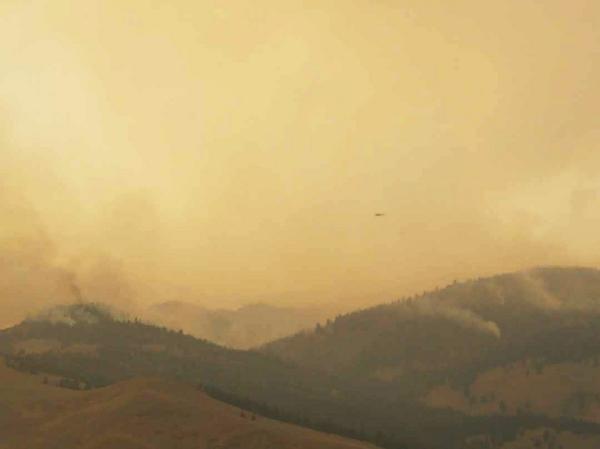
For me, it was a final recon for Alderspring cattle. I just wanted to make sure I wasn’t missing anyone, even though the range crew had counted, they believed, accurately. It was more for my peace of mind than anything. The other thing I needed to see firsthand was where my derelict broken Chevy pickup was in relation to the fire. I knew exactly where the truck was, but I wasn’t sure where the fire was. I had heard mixed reports: some fire guys had said that it was toast and now just a smoking hulk of blackened metal; others had said they spotted it, blue and intact from the air. Either way, fire was in close proximity—within a hundred yards I was guessing. One more day of wind driven firestorm would incinerate it.
What was it doing there? Three gals on Alderspring’s range riding crew had left it up there after the water pump spontaneously seized up and the cooling fan took off on a trip right through the radiator. Immediately the truck overheated, and the girls wisely killed the engine. So much for their mission: to salvage camp before the fire incinerated it.
I knew Ethan and I could cobble it back together, probably on the spot, and if nothing else, drive it out using the force of gravity. There was almost 4000 feet of elevation difference between it and highway 93, at the bottom of the range. If the brakes held, we could coast it for miles. But the Forest Service had closed the area, and I could no longer get to my truck.
After I got up from under the bike and inspected damages (clutch lever bent and broken; left leg fairly mashed and bleeding), I looked across the Big Hat Valley, spread out far below me. The wind had rolled back the smoke enough to see across it. Clearly, trees were blackened and currently burning on the other side of the small valley, about 3 miles away, but the timber I knew the pickup rested in was still completely green and smoke free. Fire was all over above it, but the pickup was safe for now. I scanned all the places I knew cattle would normally congregate at this time of day. Nothing. Clean.
It was all I needed to know. I could now report back to my Interagency Incident Command Team Liason to see if I could wrangle some permission to go into no-mans land and rescue Old Blue Chevy. The pickup wasn’t worth the $5000 fine that I would get pasted on me if I violated the closure area without authority to do so.
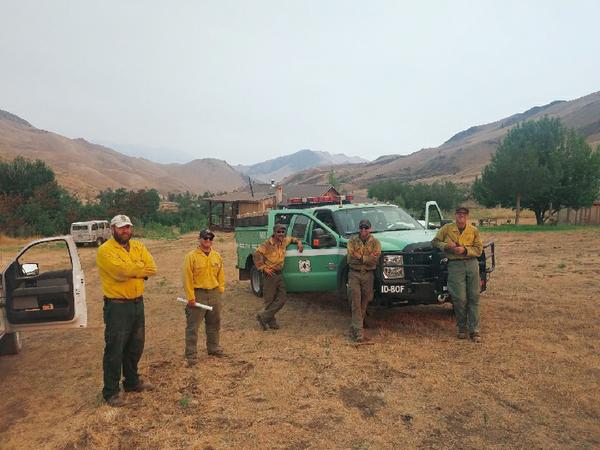
As I continued my descent of the Great Wall, I passed a hard-hatted and dirty yellow shirted entourage of 20 members of the firefighting elite. They were the Boise HotShots, pounding in a hand line, scratching with Pulaski and shovel down to mineral soil, descending the steep mountainside to Hat Creek. It would be their contingency if the fire came roaring out of the timbered heights to the popcorn-dry sagebrush below. I knew from my firefighting days what the plan was.
If said firestorm happened, crews would actually start a fire with hand-carried drip torches along the fire’s side of the mineral soil scratch to meet the fire front and stop it. It was called a backburn, and I’d seen several successfully pulled off. A risky venture, to be sure, because the line had to hold. If it didn’t, the fire could conceivably get a new foothold and license to roam unfettered for miles beyond the fire line. And the blame could rest squarely on the crew responsible for lighting said fire.
It could work.
However, there has been no need. Yet.
You see, just two days later, as we packed our Monday beef orders at our fulfillment warehouse in Salmon, Idaho, the hot afternoon sun bearing down from the west stopped bearing. We couldn’t see from our valley location what was happening; we thought perhaps the fire blew up again, and the massive volcanic column of smoke was rearing up to the stratosphere and blocking the sun. But the sky continued to blacken, now accompanied by a mighty wind from the south. Dust devils blew dry leaves and dust high into the sky. Eyes squinted in the airborne fray of dust. Outlines of the surrounding peaks, made vague by the continual pall of Rabbit Foot Fire smoke, faded, and disappeared completely into a solid monochrome gray.
The wind turned from hot to chilling. Several of us had gathered outside, taking a break from packing orders inside, to see what was unfolding, as we gazed toward the charcoal curtain that obliterated the column of the Rabbit Foot from view. We stood firm in the chill wind, shirtsleeves rippling, voices silenced.
And then, there was a resounding thump, and a corresponding puff of dust at our feet. And another. And more. Fat raindrops, driven by the incessant wind, pelted our faces. We stood our ground and gratefully received God-given rain. Hands were raised, feeling, thankful, free, released from the brittleness of environs permeated by dry burning smoke.
It rained. It was rain like we hadn’t seen since May. Rain that came down in sheets, making puddles on the parched earth. Rain that stopped the inexorable progression of fire across the Salmon River Mountains.
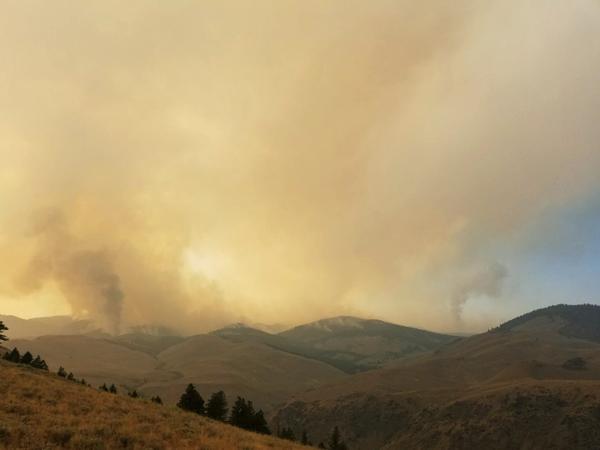
As the rain fell, we all could feel the weight of the burden lift. We hadn’t even realized we’d been carrying it. It was a burden of large and small stresses, caused by an unstoppable power: wildfire. And 600 men and women, 7 aircraft, 32 fire engines, 6 bulldozers, 7 water tenders and all the technology and intel in the world were absolutely, hopelessly powerless against it. It was Nature. Unbridled. And quite furious.
And we were given a respite.
Finally, we would sleep well that night.
That was last week. Since that time, the footprint of the Rabbit Foot has barely increased. We’ve retrieved Old Blue from the still smoking forest (a story for another day), and although the fire could yet still consume forest and range, it gets less likely by the day that it will spread any great distance. Fall will be soon upon us, and with that will come the welcome sight of the first snows, dusting the mountains.
I know it will be. It always has been. There are signs of the times: the elk have already come down to the river bottoms; soon they will be bugling in the rut, heralding in the onset of fall. I’ll hear them from our open bedroom window. The Chinook salmon have completed their fall migration to the Pahsimeroi River, excavating their redds in the iridescent gravels of the spring fed waters. They’ve traveled their 900 miles from the Pacific to spawn on Alderspring. These things and others in nature know the time and the season; the weather will follow as days become shorter and the fall rains come.
And we take comfort in that. There’s a deep gratitude for the change of seasons, and there will be an end to fire. And we’ll inhale deeply draughts of pure and pristine mountain air when the wet winds from the North bring their cleansing whims upon this smoke filled atmosphere, and once again, the luminescent sweep of the Milky Way will dominate the night sky.
Happy Trails.
Glenn, Caryl, Cowhands and Girls at Alderspring.

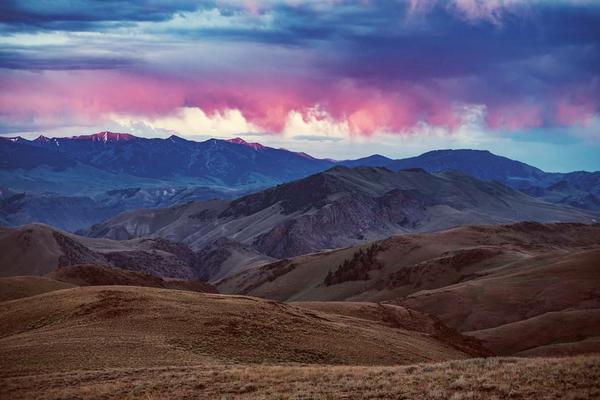
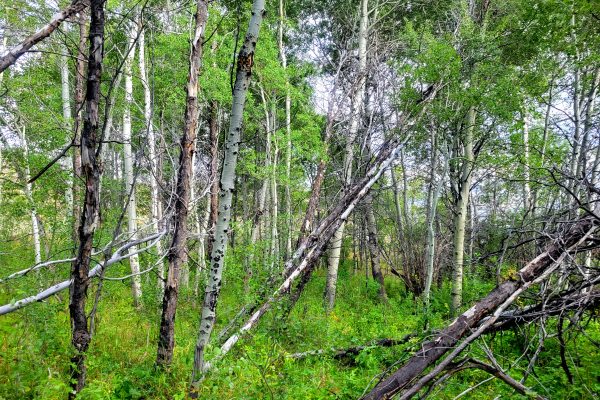



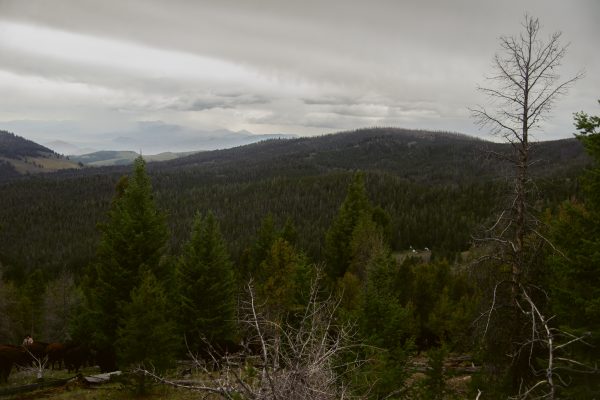
Leave a Reply